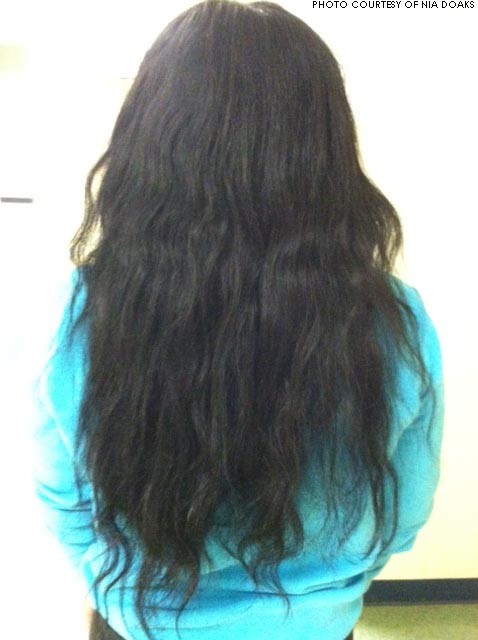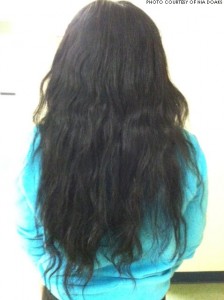

Hair. It can be long or short, straight or curly, thick or thin. It can be a variety of colors and textures. It can be styled in hundreds of different ways. All in all, the stuff on top of our heads is an important aspect of appearance– and each person’s hair is unique in its own way.
One of the most obvious differences in hair occurs by ethnicity. Each ethnicity has a specific way that they take care of their hair. African Americans, Caucasians, and Hispanics have various hair types.
African-American hair is one of the most distinguishable in appearance. Most black people have hair that is thick with tight, small curls. They have flat-structured follicles which cause the hair to grow tightly coiled.
This type of hair is dated back to African culture– and is considered ‘unattractive’ in mainstream culture– both black and white. For that reason, many black people (especially females) change their hair to be socially accepted by the dominant culture.
During the Civil Rights movement, African Americans used their hair to link themselves to their African ancestors and to other Blacks. They saw their hair as a sense of ‘black power’– during this time, it was common for African Americans to wear their hair in an afro style.
The afro was meant to go hand-in-hand with the ideas of the Black Panther group (who pushed for equality between races). An afro, in African American culture, conveyed a sense of racial pride.
Today, afros aren’t seen in the same way. Some African American women will go to extreme lengths to have their hair straightened.
There are multiple ways to do this. The first is to get the hair chemically straightened, also known as getting a ‘relaxer’. A relaxer is a type of lotion or cream used to “relax” the natural hair.
The relaxer is applied to the roots of the hair, where it is left for a few minutes. During this time, it alters the hair’s structure through controlled damage of the proteins in the hair. These chemicals can be dangerous when hair isn’t treated correctly.
Overuse of relaxers can greatly damage the hair– it can become brittle, dry, or even fall out. After relaxer applications, the shampoo and conditioner that are used immediately afterwards need to neutralize the hair.
If used correctly, the end result is pleasing– longer, straighter hair. This process is repeated every 6-8 weeks in order to get the desired appearance of the hair.
As a young girl, I had really thick, curly hair. It was difficult to manage (for my mother), and I disliked the way that it looked. Up until seventh grade, I would get my hair braided constantly.
There came a point where both my mother and I were tired of going through this process. We realized that, if I were to get relaxers in my hair, it would be easier for me (and her) to manage.
For me, it was never consciously a matter of ‘assimilation’ into the dominant culture (especially not at 12 years old)– I just wanted my hair to be straight because it was easier to handle. To this day, I continue to get relaxers every 8-10 weeks.
“I got relaxers from elementary school until about ninth grade,” said Nikki Miller, a senior. “I stopped because my aunt had cancer and wanted our family to take a more natural and healthy approach to life.”
Miller said that her hair was easier to manage when she had a relaxer. Today, she uses a lot of moisturizers, conditioners, and oils in her hair. It either has to be up or braided, and only stays straight for two days.
Another way to have the appearance of straight hair is to get weave. Weave is synthetic or human hair that is added to or used to cover the natural hair. By getting weave, one can have the appearance of long, straight hair– when in fact the hair may be short.
Weave is a less damaging way to give the appearance of straight hair. There are multiple ways that a weave can be put in.
Some weaves can be clipped-in to mix with the natural hair. This is the least invasive way to put weave in, but also lasts the shortest amount of time. These cost around $100-$200, and are for a more temporary look– the clips can easily be taken out and put in.
Another way that weave can be put in the hair is through the ‘track and sew’ method. The ‘tracks’ are cornrows that are braided in the direction that the hair will fall. The hair is then sewn into the braids, to give the appearance of straight hair. This is the most common type of weave and generally the most expensive.
Weave hair usually comes from foreign countries, such as China, India, and Korea. Most weave hair can be treated in the same way as natural hair– one just has to follow the instructions of the manufacturer or hairdresser.
“One reason I wear weave is because it’s like a hobby for me. I have fun putting it in,” says Chasidie’ Glover, a senior. Glover has experimented with wearing weave since her sophomore year.
“I just want to clear something up– people don’t wear weave because we don’t have hair,” she said. “We do it because it’s easier to manage. For example, if I wanted to dye this weave I could without having to worry about damaging my own hair. I just have fun with it.”
Those who don’t chemically straighten or add hair to their head are considered ‘going natural’. Many women take pride in this, and see it as a sense of freedom.
“I don’t have a strong opinion on what people do with their hair. I’m natural because of [family reasons],” said Miller. “I think that what people do with their hair is all about personal preference.”
Chris Rock’s movie Good Hair explores many aspects of African American female hair, and the reasoning behind spending excessive amounts of money to get it done. In Black culture, it is not rare for a female to spend large amounts of money to make her hair look a certain way.
Overall, African American female’s cultural identity no longer seems to be defined by hairstyle. Chris Rock’s ending message, which everyone should remember, is this– the stuff that is on top of your head is not nearly as important as the stuff that’s inside of it.